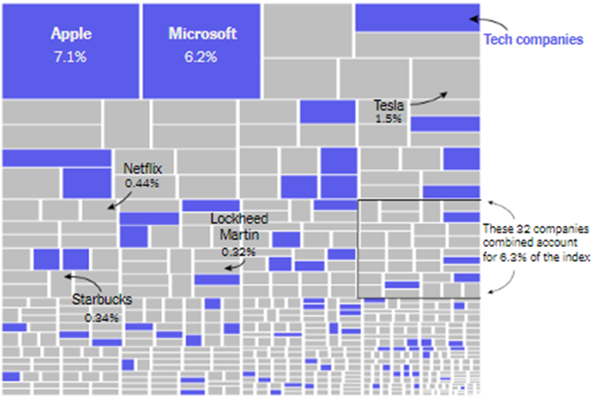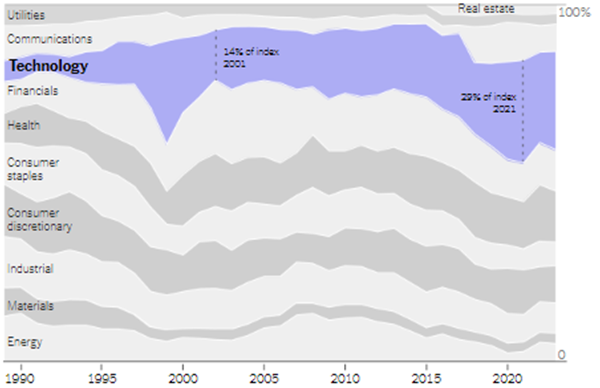How Big Tech Camouflaged Wall
Street’s Crisis
By Joe
Rennison Graphics by Eli Murray
March 31, 2023
The fate of the S&P 500 index — used by
investors as a barometer for the health of corporate America, and cited by
presidents as a measure of their handling of the economy — often comes down to
just two companies: Apple and Microsoft.
|
The companies
that make up the S&P 500, sized by share of market value.

Source: S&P Dow
Jones Indices • By Eli Murray |
This means it’s hard to invest in the U.S.
stock market, such as through a 401(k) or pension plan, and not be highly
dependent on the fate of the two tech giants. More than $15 trillion in assets,
from pension funds and endowments to insurance companies, are linked to the
performance of the S&P 500 index in some way, according to S&P Dow Jones
Indices, with more than 10 cents of every dollar allocated to the broad index
flowing through to Microsoft’s and Apple’s market valuation.
It is a phenomenon explained by how the
benchmark is constructed, and it is amplified by the way tech has come to dwarf
other industries, in the markets and the economy. And it means that the two
companies together can sway the direction of the broad market, sometimes masking
turmoil that has taken place underneath.
Trading in March offers a clear example.
Even after the failures of two regional banks in the United States and the
rescue of a global
investment bank in Europe sent a jolt through the financial system
and raised new fears about an already fragile global economy, the S&P 500 ended
the month up 3.5 percent.
Apple and Microsoft accounted for about
half of that gain, according to data from S&P. Both were seemingly immune to the
banking crisis and boosted by fervor over artificial intelligence, with Apple
rising 11.4 percent during the month and Microsoft 15.6 percent.
It can be jarring for investors to see the
index perform so differently from what they may have predicted, said Fiona
Cincotta, a stock market analyst at StoneX, a brokerage.
“It’s phenomenal that two companies can
direct so much power within the S&P 500,” she said. “These two companies seem to
have been single-handedly directing the index.”
It was true even at the height of the
frenzy. On Monday, March 13, immediately after the government seized Silicon
Valley Bank and Signature Bank, signs of panic were everywhere:
Several regional banks suffered their worst day ever in the stock market, with
First Republic Bank down more than 60 percent, in conditions so chaotic that
trading in many individual stocks was halted as stock exchanges tried to limit
the damage.
Outside the stock market, government
bond yields went haywire, oil prices slid and the dollar weakened,
all showing that alarms about the economy were ringing on trading desks around
the world.
Yet the S&P 500 spent much of the day in
positive territory, and it ended with a barely noticeable decline of 0.1
percent. Credit, again, goes to Microsoft and Apple, which both rose enough to
counter a 15 percent slide in the entire regional banking sector that day.
Much of this comes down to how the S&P 500
is designed. Its value is calculated by a measure that considers the overall
market capitalization of a company. It means the stock moves of the largest
companies carry the greatest weight, because even slight changes in their value
create or destroy billions of dollars of shareholder value.
|
As one of 11
sectors that make up the S&P 500, the tech industry accounts for more
than a quarter of the stock index’s value.

Source: S&P Dow
Jones Indices • Categories are sized by market value. •
By Eli Murray |
Apple, at roughly $2.4 trillion, and
Microsoft, at $2.1 trillion, are so large that, taken together, the two
companies would be the third-largest sector of the index, behind tech and health
care. They would be larger than the energy sector and roughly the size of the
financials sector.
This influence is a result of a
decades-long shift in both the markets and the economy since the dot-com boom, a
change that accelerated after the 2008 financial crisis. Low interest rates put
in place to support the economy after the Great Recession made borrowing cheap
and pushed investors to seek out higher returns from riskier companies, spurring
financing and growth for tech companies. Apple and Microsoft excelled.
Apple in 2018 became the first American
company valued at more than $1 trillion on the stock market. As its value
inflated, so did that of its rivals Facebook (now Meta), Amazon, Netflix, and
Google (now Alphabet) — a group that came to be called the FANG
stocks. They helped to lift the index to new highs over a more than
decade-long bull
market. Since then, Apple and Microsoft have become proportionally
much larger, more than twice the size of the next largest company.
This dynamic is not wholly unusual in the
history of the S&P 500, though it is extreme, and it has been exacerbated by the
rapid growth of some tech companies through the pandemic. (At the end of 2018,
Microsoft’s and Apple’s combined index weight was less than Apple’s is today on
its own.) The previous company to reach Microsoft’s 6.2 percent weight in the
index was IBM in the mid-80s, based on data for the end of each calendar year.
“I don’t think it’s a problem,” said
Howard Silverblatt, senior index analyst at S&P Dow Jones Indices. “This is what
the whole thing is worth, and if Apple or Microsoft go up or down, there is
proportional impact because they are worth more. It’s market-driven.”
The S&P also produces an “equal weight”
index, where each stock has the same effect on the wider group. In March, that
index fell 2.6 percent.
Another commonly cited measure of Wall
Street’s performance, the Dow Jones industrial average is a price-weighted index
that has been criticized for how it emphasizes companies based on their share
price alone.
And then there are the underlying sectors,
which are also tracked in separate indexes by S&P. These indexes, which tend to
more directly show pain afflicting their subsets of stocks, show that the
financial sector fell almost 10 percent in March, while energy stocks dropped
0.5 percent and real estate companies slid 2.1 percent. They also show that
other parts of the market — like utilities — fared just fine.
“There were so many sectors that
underperformed and were in the red across the month, and that was completely
pushed over and overshadowed by the gains in big tech,” Ms. Cincotta said.
S&P Dow Jones Indices, which maintains the
S&P 500 as well as the Dow, has tried to address the impact of these specific
weightings, at least on different sectors. In 2018, it moved Alphabet and Meta
out of the tech sector and into the communications category with Netflix, while
leaving Amazon in the consumer discretionary category with other retailers.
Since then, Meta, Amazon and Alphabet have
slowly lost value, while Apple and Microsoft have grown. The technology sector
in the S&P 500 has also been bolstered by the emergence of new behemoths like
the chip maker Nvidia, which is valued around three quarters of a trillion
dollars.
This month, S&P sought to rebalance the
index again, moving a handful of large tech-oriented companies — like Visa and
PayPal — into the financials sector, but further entrenching Apple and
Microsoft’s dominance as the two tech heavyweights.
Of course, this cuts both ways. In 2022,
the S&P 500 slumped close to 20 percent, a drop that would have been much
smaller without the lousy performance of the tech sector. Apple and Microsoft
together accounted for roughly one-fifth of the index’s total decline last year.
But for now, analysts see reasons for tech
to continue to rally.
One reason is the excitement over
artificial intelligence. Microsoft has a large stake in OpenAI,
the creator of ChatGPT, and many investors foresee the nascent technology
driving the next phase of growth for the companies developing the software as
well as the chip makers whose processors power it.
Tech stocks are also benefiting from the
concern over the country’s banks, which has led investors to quickly cut back
their expectation for interest rate increases from the Federal Reserve. The
sector is particularly sensitive to interest rates, and absent an imminent
recession, lower rates in the future would be a boost for the sector.
And, analysts said, large technology
companies have become havens where investors can wait out the current storm.
“It’s been a big bull cycle for tech,”
said George Catrambone, the head of Americas trading at DWS, a fund manager. “I
don’t think people will give up that paradigm easily.”
A correction was made on March
31, 2023: An earlier version of
this article misstated the impact Apple and Microsoft had on the S&P 500 in
2022. The two companies accounted for about one-fifth of the index’s losses last
year, not most of the losses.
When we learn of a mistake,
we acknowledge it with a correction. If you spot an error, please let us know
at nytnews@nytimes.com.
Learn
more
Joe Rennison covers financial
markets and trading, a beat that ranges from chronicling the vagaries of the
stock market to explaining the often-inscrutable trading decisions of Wall
Street insiders.
A version of this article appears in print on April
1, 2023,
Section B, Page 1 of the New York edition with the headline: How Big Tech
Camouflaged Wall Street’s Crisis.
© 2023 The
New York Times Company